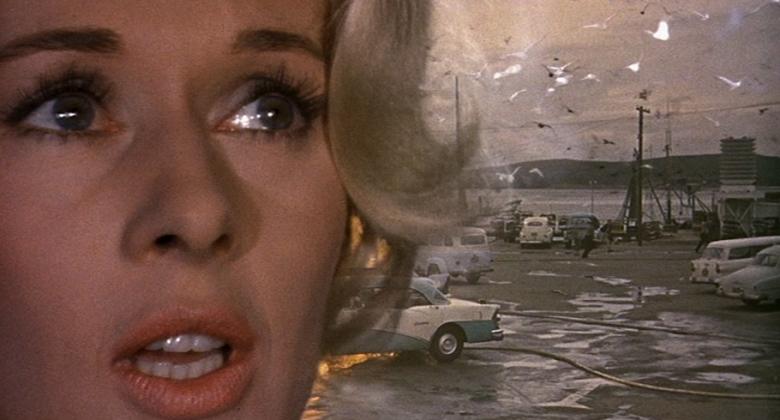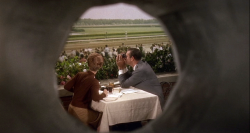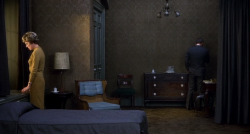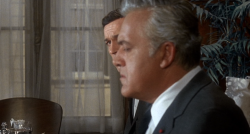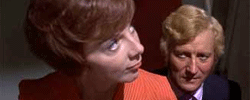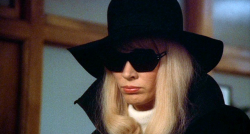Reviews
Alfred Hitchcock
USA, 1963
Credits
Review by Leo Goldsmith
Posted on 23 October 2012
Source Universal Studios DVD
Related articles
Reviews
The Birds
External links
Oskar Sala’s sound effects from The Birds
Categories Late Hitchcock
Black and white, jackdaw and gull, mingled in strange partnership, seeking some sort of liberation, never satisfied, never still. Flocks of starlings, rustling like silk, flew to fresh pasture, driven by the same necessity of movement, and the smaller birds, the finches and the larks, scattered from tree to hedge as if compelled.
—Daphne du Maurier, “The Birds”
Much of the scholarship around Alfred Hitchcock’s The Birds - and, indeed, much of the fascination - centers around the canny decision by the director and his screenwriter Evan Hunter not to reveal the cause of the avian assault on Bodega Bay that forms the central conceit of their film. (Hitchcock to Hunter, better known to pulp fans as Ed McBain: “I’m sure we are going to be asked again and again, especially by the morons, ‘Why are they doing it?’”) This simple decision makes The Birds stand out from nearly all of the rather more logical and spelled-out natural disaster films that have come in its formidable wake, but it’s a self-conscious gesture on Hitchcock’s part, as well. Just as the penultimate scene of Psycho proposes a coldly analytical interpretation of that film’s events - an interpretation that, like the shot that follows it, manages to dredge up the truth but not to assuage the overall sense of dread and uncertainty - The Birds also proposes its share of rational explanations, but they offer neither satisfaction nor comfort.
Somewhere in the middle of the film, inside The Tides restaurant, the film proposes a few possible, but ultimately unsatisfying explanations (which Robin Wood enumerates in his remarkable essay on the film): the birds might attack, first, as revenge for humanity’s ill treatment of them or of nature generally (hinted at in Mrs. Bundy’s skeptical remark, “It is mankind, rather, who insists upon making it difficult for life to exist on this planet”); second, as a moral punishment for humanity’s sins (hence the drunk’s repeated cries of “It’s the end o’ the world!”); and third, as the literal or figurative materialization of one or more of the characters, their states of mind or interpersonal conflicts. Thus, the hysterical mother’s terrifying accusation to Melanie Daniels is that she, a glamorous heiress and incidental visitor to the town, is the cause: “I think you’re evil! Evil!” Melanie’s slap across the woman’s face puts an end to the matter for the moment, but this notion is not as easily dismissed as all that. For one, the accusation points not simply to a supernatural cause, but to an authorial one, as well. If there is no scientifically plausible reason for the attack of the birds, we are nonetheless constantly reminded that there is at least a reason for Hitchcock’s staging of the attack, and for narrating the attack through these particular characters.1
This sense of the interrelatedness of the characters’ psyches and the violent actions of the birds is borne out by the way the film routinely emphasizes the human over the avian. The impulses of the birds themselves, unusual as they are, are not the subject of nearly so much discussion as those of the human characters, which seem routine, even melodramatic, by contrast. Think of the rather elaborate, maybe even implausible nature of the film’s set-up: vain, spoiled rich girl Melanie Daniels flirts with handsome lawyer Mitch Brenner in a San Francisco pet store, is embarrassed by him, and proceeds to go to great lengths to exact revenge. This includes tracking him down using his license plate number, buying him a pair of lovebirds (which are ostensibly for his sister Kathy), and delivering them to his weekend home in Bodega Bay, some distance from the city. Throughout the first part of the film, Melanie’s stiff, even bird-like manner and Mitch’s condescending moralism mask a set of contrary impulses: desire competing with spite, domesticity with self-interest, generosity with vanity.2 But Hitchcock practices a sly bait-and-switch, collapsing our confusion and bewilderment about the behavior of humans with that of the birds, and the film exploits this behavior on the part of both species as, at once, an obstacle to the formation of the couple and the very means by which this formation will be enacted.
It is little wonder that both Wood and, most notably, Raymond Bellour have emphasized the importance of the early scene in which Melanie crosses and re-crosses the bay, delivers the lovebirds, and is finally attacked by a seagull. Wood focuses on the complex system of identification Hitchcock establishes in this scene, and Bellour details the ways in which the film plays with doublings (or “rhymes”) of looks and framings, point-of-views shots and eyeline matches. But what is most significant about this sequence, even before Melanie’s self-satisfied smile and cock of her head is answered by a dive-bombing seabird, is the way in which it forces us to pay attention to Melanie’s vulnerability. In the middle of this large and open body of water, she is exposed both physically, in her small open boat with an ominous (and flagrantly rear-projected) skyline overhead, and romantically, in her pursuit of Mitch Brenner. She is trying - and probably failing - to be neither “too aloof” nor “too demonstrative,” as Mitch requested of the lovebirds, but it is a delicate balance and there are still more challenging traversals of this tightrope ahead, more complex negotiations of both internal and external forces.
Certainly, one of the major forces Mitch and Melanie must contend with is Lydia, Mitch’s skittish, deeply skeptical mother. Primed by Psycho, we might interpret Lydia’s raised eyebrow and emotional distance as the double of Mrs. Bates, the kind of spectral presence that could summon Norman’s stuffed raptors to flight. Hitchcock toys with this idea knowingly, and even lets us revel in Lydia’s timid attempts at catty gossip about Roman fountains and Melanie’s profligate high-society hi-jinks. But Annie Hayworth, Mitch’s ex and little Kathy Brenner’s schoolteacher, soon steps in with her own counter-Freudian interpretation:
So, what’s the answer? Jealous woman, right? Clinging, possessive mother? Wrong. With all due respect to Oedipus, I don’t think that was the case.
As Annie explains, Lydia is not a domineering matriarch, but a fragile creature whose fear of abandonment makes her more than “a trifle distant.” And Annie could well be describing herself, too—she clearly still carries a torch for Mitch somewhere amid her modernist art collection and Tristan und Isolde records. Or indeed, perhaps she’s talking about all of the characters: the motherless Melanie Daniels, “neither poor nor innocent,” who busies herself studying semantics at Berkeley and helping a little Korean boy through school; or even the fatherless Mitch Brenner, a capable but wholly ineffectual hero, who associates with hoods and wife-murderers in San Francisco all week and then plays the dutiful son and brother on weekends. For the majority of the first part of the film, these characters, with their puzzling needs and nebulous emotional histories, are continually held up for scrutiny and discussion by the other characters and even by these characters themselves.
So, “this business with the birds” seems more a pretext for the psychic rehabilitation and reconnections of the characters rather than the other way around. Eventually, through great emotional labor and physical trauma, some of the characters begin to open up to one another about their isolation and despair. Speaking of her life after her husband died, Lydia confides in Melanie, “It’s terrible when you depend on someone else for strength, and suddenly all the strength is gone and you’re alone.” And this explains why Hitchcock is so inventive in finding ways to isolate his characters in the frame, both agoraphobically and claustrophobically, as it were. The central scene of destruction in Bodega Bay, which immediately follows the debate at The Tides, offers a number of these variations, from the static shots of Melanie framed helplessly in the window, reacting to the chaos in quick, expressionistic close-ups, to that ominous god’s-eye (bird’s-eye?) view of the town bisected by a ribbon of flame.
In this sense, too, The Birds represents better than any other Hitchcock film the extreme polarities of his universe: vicious unpredictability and moral and emotional disorder on the one hand, and rigorous stylistic control and formal organization, on the other. These contrasts are often at play in the director’s work, but here they take on an almost compulsive quality, allowing Hitchcock full control over the orchestration of chaos and leaving his characters with no consolation but each other’s companionship.
- In Du Maurier’s story, the theory is advanced that the Russians have poisoned the birds, a hint particular to that story that the birds have something to do with the then-recent experience of the London blitz and of war in general. Curiously, though he would explore Cold War anxieties in two films later in the decade, the Russian theory is not voiced here. ↩
- As always in Hitchcock, costuming is crucial here: Melanie’s jewelry consists of a matching bracelet and necklace of intertwined black and white pearls. Rhyming with the opening credit sequence of abstract black bird-forms fluttering violently against a white background, this establishes a pattern throughout the film of messy, competing black and white patterns, repeated in the costumes of all of the adult main characters: Melanie, Annie, Lydia, and Mitch all wear speckled black-and-white outfits at some point in the film. ↩
More Late Hitchcock
We don’t do comments anymore, but you may contact us here or find us on Twitter or Facebook.



